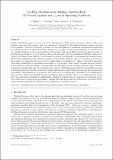| dc.contributor.author | Bakshi, A | |
| dc.contributor.author | Altantzis, C | |
| dc.contributor.author | Glicksman, LR | |
| dc.contributor.author | Ghoniem, AF | |
| dc.date.accessioned | 2021-10-27T20:05:12Z | |
| dc.date.available | 2021-10-27T20:05:12Z | |
| dc.date.issued | 2017 | |
| dc.identifier.uri | https://hdl.handle.net/1721.1/134480 | |
| dc.description.abstract | © 2017 Elsevier B.V. Gas-flow distribution plays a critical role in the performance of fluidized beds because it directly affects gas residence-time and solids mixing. However, measuring it accurately in the harsh conditions of larger reactors is not possible. Therefore, this study is focused on the development of a rigorous computational framework for quantifying gas-flow distribution during fluidization. To this end, fine-grid simulations are conducted for the bubbling fluidization of two distinct Geldart B particles - 1.15 mm LLDPE and 0.50 mm glass particles, at superficial gas velocities U/Umf = 2 and 3 in a 50 cm diameter bed. The two-fluid model (TFM) is employed to describe the solids motion efficiently and in-house developed tool MS3DATA (Multiphase-flow Statistics using 3D Detection and Tracking Algorithm) to compute detailed bubble statistics. The overall gas flow is divided into three phases: (a) dense flow in areas relatively rich is solids concentration (b) “visible” bubble flow associated with rising bubbles and (c) throughflow accounting for the gas flow which mostly bypasses through bubbles. It is found that conditions within the dense-phase depend largely on the particle properties while bubbling dynamics are significantly affected by superficial gas velocity. Calculations show that the throughflow increases in areas frequented by bubbles because the voidage distribution around bubbles increases the local dense-phase permeability. Throughflow may account for up to 40% of the overall gas flow, especially in the fluidization of large particles. This is not desirable because its residence-time is almost 2 × shorter (as compared to the dense flow) and contributes minimally to solids mixing. Finally, it is shown that in comparison to lab-scales, larger beds exhibit more homogeneous gas mixing. Insights from this study and the methodology developed will be useful in investigating gas flow distribution in complex fuel conversion systems. | |
| dc.language.iso | en | |
| dc.publisher | Elsevier BV | |
| dc.relation.isversionof | 10.1016/J.POWTEC.2017.01.005 | |
| dc.rights | Creative Commons Attribution-NonCommercial-NoDerivs License | |
| dc.rights.uri | http://creativecommons.org/licenses/by-nc-nd/4.0/ | |
| dc.source | Other repository | |
| dc.title | Gas-flow distribution in bubbling fluidized beds: CFD-based analysis and impact of operating conditions | |
| dc.type | Article | |
| dc.contributor.department | Massachusetts Institute of Technology. Department of Mechanical Engineering | |
| dc.relation.journal | Powder Technology | |
| dc.eprint.version | Author's final manuscript | |
| dc.type.uri | http://purl.org/eprint/type/JournalArticle | |
| eprint.status | http://purl.org/eprint/status/PeerReviewed | |
| dc.date.updated | 2019-09-26T14:27:17Z | |
| dspace.orderedauthors | Bakshi, A; Altantzis, C; Glicksman, LR; Ghoniem, AF | |
| dspace.date.submission | 2019-09-26T14:27:20Z | |
| mit.journal.volume | 316 | |
| mit.metadata.status | Authority Work and Publication Information Needed | |
